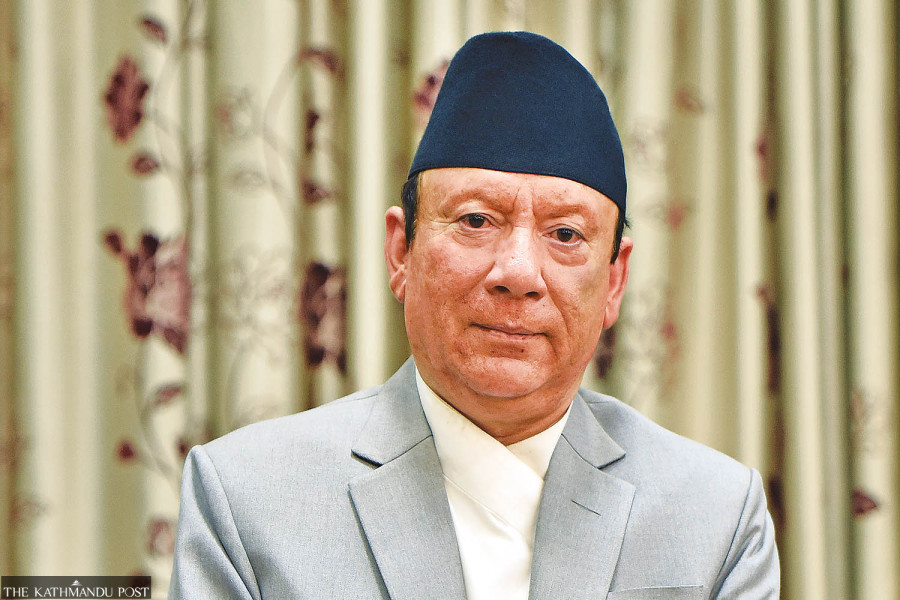National
Raut takes charge of the judiciary
The chief justice’s top challenges are repairing ties with Bar and addressing corruption.
Binod Ghimire
Chief Justice Prakash Man Singh Raut assumed office on Sunday as the new head of the judiciary.
Raut, who was appointed as the top court justice in August 2016, took over the charge of one of the three state organs after being appointed to the position by President Ramchandra Paudel. The chief justice is the topmost position in the judicial service. It is a big achievement for Raut, but the road ahead for him will be far from smooth, observers say.
The bar-bench tussle continues, and different tiers of courts await the recruitment of judges while the Supreme Court remains squeezed with workload. Raut’s first challenge is to mend the relationship with the Nepal Bar Association (NBA) that was strained after the Judicial Council in September last year amended its regulations.
As per the amendment that came into effect on September 20, 2023, the chief registrar of the Supreme Court or the council secretary, if appointed a high court judge, would be ranked immediately below the chief judge of the high court.
The association has demanded the provision be revoked, describing it as regressive, biased, discriminatory, arbitrary, and unconstitutional and arguing that it contradicts the principles established by the Supreme Court’s verdicts. It claims that the amended provision of the regulations unfairly demotes judges appointed from among lawyers, placing them below career judges in the hierarchy.
Its demand to scrap the amendment continues. Then, as a member of the council, Raut had consented to revisit the amendment. Also, he as a coordinator of the panel formed to find a meeting point on the matter had failed to resolve the dispute.
The differences between the bar and the bench escalated to the point that a full court concluded that Gopal Krishna Ghimire, the association's president, should face legal trial for criticising the justice appointment amid lawyers’ protest. A contempt of court case has been lodged against Ghimire for his remarks that financial dealings were involved in the justice appointments. But the top court deputy registrar, who filed the case, has announced withdrawal of the case.
Raut as judiciary’s leader has a challenge to bridge the differences. Those who have worked with him say having led a lawyers’ body in the past he understands how to handle the matter. “Once a chair of the Supreme Court Bar Association, he is now the chief of the judiciary. He understands the sensitivities of both the institutions. I believe he will be able to resolve the ongoing rift,” Ananda Mohan Bhattarai, a former justice who was appointed in the top court together with Raut, told the Post.
Raut was the chairperson of the Supreme Court Bar during the second people's movement in 2006. His family had long been associated with the Nepali Congress.
Like Bhattarai, NBA office-bearers are also hopeful about the resolution of the year-long dispute. “We will find a way out through dialogue. The Bar is optimistic,” Anjita Khanal, general secretary of the NBA, told the Post.
Raut’s former colleagues say as the judiciary has been heading in the right direction post Cholendra Shumsher Rana, he has the responsibility of keeping up the momentum and further increasing public faith in the judiciary. “As far as I know him, he is capable of doing so,” said Bhattarai.
In over eight years in the judiciary, he hasn’t been embroiled in any serious controversies and has a relatively fair image. However, not many view him as particularly competent in justice delivery and administration. “No doubt, he was a well known lawyer of his time but he is not regarded as a competent justice,” a retired official at the judiciary who knows him told the Post. “I doubt there will be any remarkable reforms under him. But he will also do no harm intentionally.”
Currently, the top court is short of four justices after the recommendation of Nrip Dhwoj Niroula and Nitya Nanda Pandey as justices last week. Though the rate of clearing the cases has increased, the top court still has 25,000 cases in its docket.
Filling the vacant positions at earliest possible is vital to boosting the clearance rate.
Similarly, the high courts have 16 judges’ positions vacant. As a chairperson of the council, it is Raut’s responsibility to make timely and merit-based appointments. What kinds of people get appointed too will determine in which direction he takes the judiciary, said the retired official.
Lack of transparency and corruption remain big challenges in the top court. Several reports including the one prepared by the Supreme Court Bar when Raut himself was its chair have pointed to irregularities in the judiciary. “Of late, transparency and accountability have improved but a lot more still needs to be done. I believe the chief justice is aware of it,” said Bhattarai.
Raut, the senior-most justice of the Supreme Court, was recommended for the role by the Constitutional Council on September 16. A holder of a Bachelor’s degree in law from the Nepal Law Campus, Tribhuvan University, he was appointed Supreme Court Justice on August 1, 2016.
According to the Supreme Court’s records, Raut served as an advocate and senior advocate from 1983 to 2016, specialising in civil, criminal, and constitutional cases. He will lead the judiciary until March-end next year before handing over the baton to Justice Sapana Pradhan Malla.




 21.12°C Kathmandu
21.12°C Kathmandu













